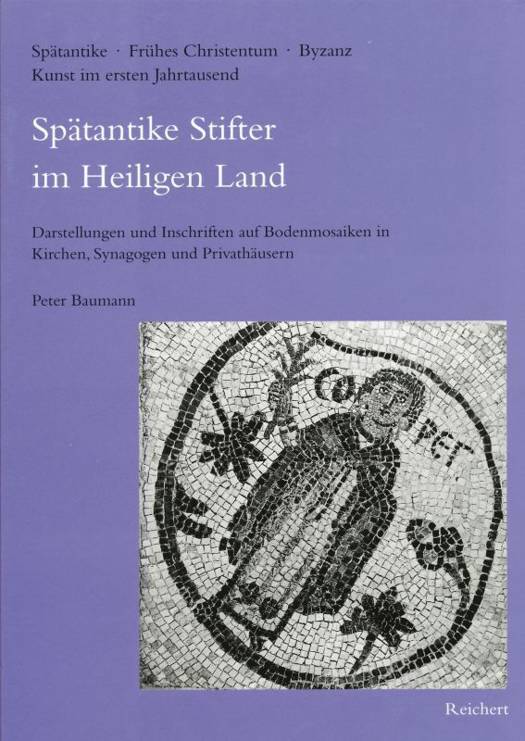
- Retrait gratuit dans votre magasin Club
- 7.000.000 titres dans notre catalogue
- Payer en toute sécurité
- Toujours un magasin près de chez vous
- Retrait gratuit dans votre magasin Club
- 7.000.0000 titres dans notre catalogue
- Payer en toute sécurité
- Toujours un magasin près de chez vous
Spatantike Stifter Im Heiligen Land
Darstellungen Und Inschriften Auf Bodenmosaiken in Kirchen, Synagogen Und Privathausern
Peter Baumann
125,95 €
+ 251 points
Description
English summary: It was thanks to the initiative of well-to-do donors that representative public buildings could be erected, decorated and renovated also during Graeco-Roman times. Who were these donors? What interests motivated them? A precise study of the furnishings of the monuments financed by them can provide answers to these questions. The basis of this work is the unusually large number of mosaic floors which were unearthed on both sides of the river Jordan. They decorated churches, synagogues and private houses and can be dated back to the time of the 6th to the 8th century AD. The figured representations and the abundantly available inscriptions bear witness to the undiminished meaning of the donor system in this region on the border of the Eastern Roman Empire. A systematic synopsis of these testimonies makes it possible to be able to determine basic aspects of the "view of the world" of these local elite persons.The mosaic programmes of the churches in khirbet umm er-rasas in Jordan unearthed during the past years are exemplarily described and analysed. The focus of interest is the question as to how far traditional forms of pictures and types of figures are adapted and/or which innovative characteristics they possess. After all, they served the purpose of displaying the high status of the donor in a distinguished manner. The knowledge gained represents the basis for a typological catalogue of the mosaic representations of donors who were well-known in the Holy Land. The formula-like expressions used in the church inscriptions of the donors supplement findings whilst the analysis of the material from synagogue buildings reveal their own accents in the contemporary Jewish environment. The volume includes extensive systematic lists on the wording of the inscriptions, general maps and indexes. German description: Grundlage dieser Arbeit ist die ungewohnlich grosse Zahl von Mosaikboden, die zu beiden Seiten des Jordans ausgegraben wurden. Sie schmuckten Kirchen, Synagogen und Privathauser und konnen in die Zeit vom 6. bis zum 8. Jahrhundert n. Chr. datiert werden. Die figurlichen Darstellungen und die reichlich vorhandenen Inschriften kunden von der ungebrochenen Bedeutung des Stifterwesens in dieser Region am Rande des ostromischen Reiches. Eine systematische Zusammenschau dieser Zeugnisse ermoglicht es, grundlegende Aspekte der "Weltsicht" dieser lokalen Eliten zu bestimmen.Exemplarisch werden die Mosaikprogramme der in den letzten Jahren ausgegrabenen Kirchen in Khirbet Umm er-Rasas, Jordanien, beschrieben und analysiert. Im Mittelpunkt steht die Frage, inwieweit traditionelle Bildformen und Figurentypen adaptiert werden bzw. welche innovativen Zuge sie besitzen. Immerhin dienten sie dazu, den hohen Status des Stifters vornehm zur Schau zu stellen. Die gewonnenen Erkenntnisse stellen die Grundlage fur einen typologischen Katalog der im Heiligen Land bekannten musivischen Stifterdarstellungen dar. Die in den kirchlichen Stifterinschriften verwendeten formelhaften Wendungen erganzen die Befunde, wahrend die Analyse des Materials aus Synagogenbauten eigene Akzente im zeitgenossischen judischen Umfeld erkennbar werden lasst.Umfangreiche systematische Listen zu den Wortfeldern der Inschriften, Ubersichtskarten und Register sind dem Band beigefugt.
Spécifications
Parties prenantes
- Auteur(s) :
- Editeur:
Contenu
- Nombre de pages :
- 484
- Langue:
- Allemand
- Collection :
- Tome:
- n° 5
Caractéristiques
- EAN:
- 9783895001031
- Date de parution :
- 01-04-99
- Format:
- Livre relié
- Format numérique:
- Genaaid
- Dimensions :
- 240
- Poids :
- 1092 g

Les avis
Nous publions uniquement les avis qui respectent les conditions requises. Consultez nos conditions pour les avis.






